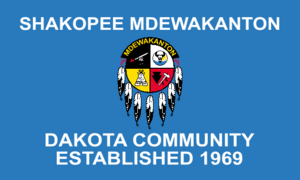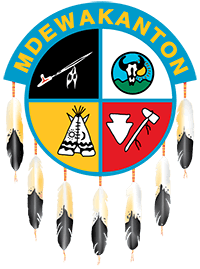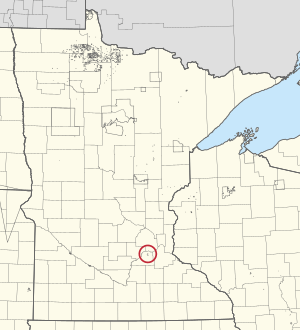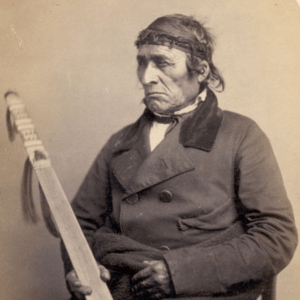Shakopee Mdewakanton Sioux Community facts for kids

Tribal Flag
|
|

Shakopee Mdewakanton Sioux Community logo
|
|
| Total population | |
|---|---|
| 658 (2010) | |
| Regions with significant populations | |
| Languages | |
| Dakota, English | |
| Related ethnic groups | |
| other Mdewakanton people, other Dakota people |
The Shakopee Mdewakanton Sioux Community (SMSC) is a federally recognized Native American tribe. They are part of the Mdewakanton Dakota people. Their home is southwest of Minneapolis and Saint Paul, Minnesota. It is located near the cities of Prior Lake and Shakopee in Scott County, Minnesota. The name Mdewakanton (pronounced Mid-ah-wah-kah-ton) means "dwellers at the spirit waters."
The tribe owns and runs popular businesses like Mystic Lake Casino Hotel and Little Six Casino. These businesses are very successful because they are close to a large city. This success helps the tribe in many ways. Each tribal member receives money each year. The tribe also gives a lot of money to different charities.
As of 2020, the SMSC reservation and other tribal lands cover about 7.99 square miles (5,110 acres; 20.7 km2). These lands are in or near the original reservation. This original land was set up for the tribe in the 1880s. Tribal lands are mainly in Prior Lake and Shakopee, Minnesota.
The people of the SMSC are direct descendants of the Mdewakanton Dakota. Their ancestors lived in villages near the Minnesota River. Important leaders called Chief Sakpe spoke for their village. The first Sakpe (pronounced Shock-pay) was named "six" because his wife had sextuplets (six babies at once). Later chiefs with the same name signed important agreements with the United States. The city of Shakopee was later named after these leaders.
Contents
Tribal Government
The Shakopee Mdewakanton Sioux Community has its own government. The main group is the General Council. This council includes all SMSC members who are 18 years or older.
Business Council
A smaller group called the Business Council handles the tribe's daily work. Three members are elected to this council every four years. They make sure the decisions made by the General Council are carried out. The current Business Council members are Chairman Cole Miller, Vice-Chairwoman Natasha Coursolle, and Secretary/Treasurer Ashley Cornforth.
History of the Dakota People
The Dakota people have lived in the Minnesota River Valley for hundreds of years. In the past, they lived off the land. They fished in the river and gathered wild rice, nuts, and roots. They also hunted animals for food.
Chief Sakpe's Legacy
The name Chief Sakpe (Shock-pay) means "number six" in the Dakota language. It was the name given to a line of chiefs in this area. The city of Shakopee was named after these important leaders. Chief Sakpe I got his name because one of his ancestors was the sixth in a set of sextuplets.
Chief Sakpe II (who died in 1860) signed important agreements with the United States in 1851 and 1858. These agreements were about land.
Chief Sakpe III (1811–1865) was a leader during the U.S.–Dakota War of 1862. After the war, many Dakota people were forced to leave their homes. Chief Sakpe III went to Canada. He was later returned to U.S. forces and died in 1865.
The U.S.–Dakota War of 1862
When European-American settlers moved into Minnesota in the 1800s, the Dakota people had a different idea about land. They believed land could be shared and used by different groups. However, the United States government forced the Dakota to give up their land. This made it hard for the Dakota to live their traditional way of life.
The new settlers changed hunting grounds and limited fishing. This meant the Dakota had less food. They had to rely on promises from the government, but these promises were often broken. Food and supplies were late or spoiled. This led to hunger and anger among the Dakota. This anger eventually led to the U.S.–Dakota War of 1862.
Hardship and New Beginnings
The U.S. Army defeated the Dakota. After the war, many Dakota men were executed in Mankato, Minnesota, on December 26, 1862. The remaining Dakota were forced to walk over 100 miles to Fort Snelling. They were held there through the winter. In 1863, Congress took away all agreements with the Dakota. They ordered them to leave Minnesota.
It took until 1886 for Congress to create new reservations for the Dakota who stayed in Minnesota. These included the Shakopee Mdewakanton Reservation. For the next 100 years, life was very hard for the Dakota people. They faced poverty and many challenges.
Community Revitalization
In 1969, the Shakopee Mdewakanton Sioux Community officially became a federally recognized tribe. This was a big step. They set up their own government and started to build their economy.
In 1982, the tribe opened Little Six Bingo Palace. This was possible because new laws allowed gaming on reservation lands. In 1992, they opened the Mystic Lake Casino Hotel. These businesses have brought in a lot of money. The tribe has used this money to create more businesses, help their community members, and give to charities. In 2023, the tribe also started a bison herd on 165 acres (67 ha) of land.
Economic Success
The SMSC Gaming Enterprise includes Little Six Casino and Mystic Lake Casino Hotel. These businesses are very important. Together, the SMSC, Mystic Lake Casino Hotel, and Little Six Casino employ about 4,100 people. This makes them the largest employer in Scott County.
In 2012, the SMSC and Canterbury Park, a horse racing track, made a special agreement. The SMSC Gaming Enterprise created a fund to help horse racing at Canterbury Park. This fund added $75 million to horse racing prizes over ten years. This agreement also created new ways for Canterbury Park and Mystic Lake Casino Hotel to work together on marketing. New races like the Mystic Lake Derby and the Mystic Lake Mile were also created.
The SMSC also owns other businesses. These include Dakota Mall, Dakotah Meadows RV Park, and the Dakotah! Ice Center. They also have Dakotah! Sport and Fitness, Wozupi Tribal Gardens, and the Mystic Lake Store at Mall of America. Other businesses are Playworks, Shakopee Dakota Convenience Stores, an Organics Recycling Facility, and a Water Bottling Facility. They also own The Meadows at Mystic Lake golf course.
The tribe also owns the JW Marriott Minneapolis Mall of America. This is a large luxury hotel that opened in 2015. Mystic Lake Center is a newer part of the Mystic Lake Casino Hotel. It has more hotel rooms, meeting spaces, and ballrooms.
Charitable Giving
The Shakopee Mdewakanton Sioux Community is very generous. They have donated over $350 million to many different groups and causes. They are the biggest giver of money to Native American communities across the country.
In 2015, the SMSC started a program called Seeds of Native Health. This was a five-year, $11 million effort. It was the largest program ever focused on improving nutrition for Native Americans.
In 2019, the tribe launched another program called Understand Native Minnesota. This is a three-year, $5 million plan. Its goal is to improve how Native American history and culture are taught in Minnesota schools.
Besides giving to charities, the tribe has also given $500 million in loans to other tribes. For example, they gave a $31 million loan to Red Lake Nation in 2010. They gave another $27 million loan in 2013. This helped the Red Lake Tribe build and run their own casino to earn money.
Reservation and Community
Geography
In 2020, the Shakopee Mdewakanton Sioux Community reservation covered about 0.41 square miles (1.1 km2; 260 acres) of land. The community also owned other trust lands away from the main reservation. These lands totaled about 7.58 square miles (19.6 km2; 4,850 acres). In total, the combined land area is about 7.99 square miles (20.7 km2).
The community has been actively working to get more land. Between 2016 and 2019, they added over 1,197 acres (1.870 sq mi; 4.84 km2) of land into trust status.
Population
According to the 2020 census, the total population of the Shakopee Mdewakanton Sioux Community and its trust lands was 779 people. The population density was about 97.5 inhabitants per square mile (37.6/km2). There were 280 homes in the area.
The people living on the reservation and trust lands were mostly Native American (63.2%). There were also White people (20.4%), Asian people (1.9%), and Black or African American people (0.9%). Some people were from other races or from two or more races. About 5.9% of the population was Hispanic or Latino.
Notable Tribal Leaders
- Norman Melvan Crooks (1917–1989), a former tribal chairman.
- Stanley R. Crooks (1941–2012), also a former tribal chairman.
- Charlie Vig (2012–2020), a former tribal chairman.




